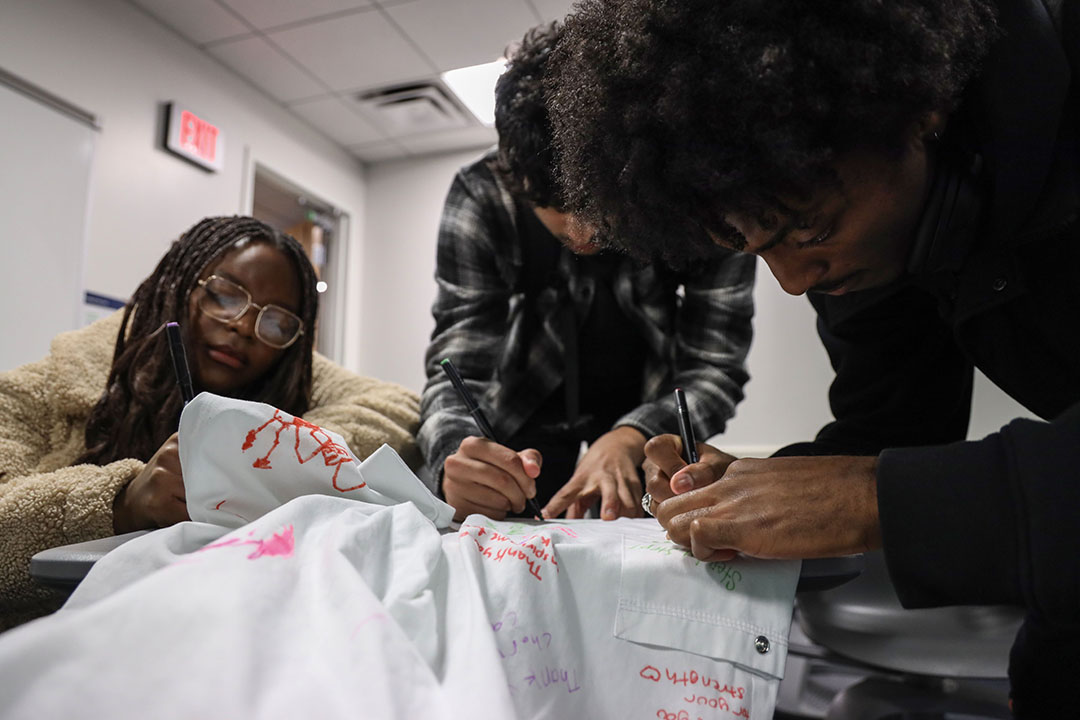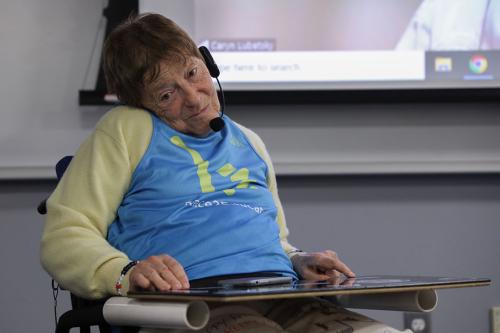In Assistant Professor of Organizational Sciences Nils Olsen’s Extreme Decisions class, students follow the split-second thinking of decision makers who’ve trained themselves to perform in high-intensity settings. And often, in Olsen’s examples, that means stepping into the sneakers of world-class athletes.
Lebron James, for example, has tenths of a second to decide whether to shoot or pass in an NBA game. Mia Hamm has no time to stop and think about which corner of the goal to aim a World Cup soccer kick.
But of all the high-stress achievers Olsen cites in class—along with surgeons, business executives and prima ballerinas—his students had never met anyone like Kerry Gruson.
A champion endurance athlete, Gruson, who visited the class in October, competes in extreme contests like ultra-marathons, Ironman triathlons and high seas sailing regattas. She holds three Guinness Book of World Records titles.
And she’s effectively a quadriplegic.
After a brutal attack 50 years ago, Gruson lost most of the function in her limbs. She’s spent much of her life in a wheelchair. Her shattered vocal cords keep her voice in a permanent hoarse whisper. But Olsen’s class hung on every word as she described how she crosses finish lines tethered to her competition partner, Caryn Lubetsky, on ocean kayaks and high-speed mountain bikes. The pair had just completed Washington’s 2023 Marine Corps Marathon—but eschewed the traditional 26 mile course for the 50K endurance challenge.
“People often feel sorry for me—I tell them don’t,” said Gruson, who founded the nonprofit Thumbs Up International to pair athletes with differing abilities. “I see obstacles as opportunities.”
Athletes staring down high-pressure games. ER staffs racing the clock to save critical patients. Fighter pilots navigating jets at 700 miles an hour. In Olsen’s class, each is an example of decision making in the face of stress, time constraints and cognitive complexity.
A social psychologist and behavioral economist, Olsen has contributed his cognitive research expertise to organizations such as the American Bar Foundation, the National Institutes of Mental Health, the U.S. Securities and Exchange Commission and the New York Stock Exchange. And for the 17 undergraduates in his seminar—whose majors range from organizational sciences and psychology to public health and business—Olsen’s class offers insights into their own decision-making process and how it impacts their interactions with others.
“Understanding the theories behind our actions gives me more knowledge of how we think,” said junior organizational sciences major Dara Reyblat. As president of the Student-Athlete Advisory Committee, Reyblat said the class has helped her better represent student-athletes with the university. “Now, when others make decisions, I understand the surroundings and situations that led them there.”
‘Gut Level’ Decisions
Olsen explains how factors like biases and emotions influence our decision making in both high-stakes crises and everyday dilemmas. “When we’re making decisions—big or small—we want to think flexibly and dynamically,” he said. “But the reality is we’re all human beings. We’re under stress that narrows our cognitive field.”
On one level, Olsen breaks extreme decision making into two systems. The first involves mastering the mechanics of a new skill to the point where it can be performed with almost no thought at all. For the NBA’s James, for example, thousands of hours of practice have made dribbling second nature. “LeBron’s high-level strategic thinking is focused three or four plays in advance,” Olsen explained, “not on the mechanics of how he bounces a ball.”
After mastering the mechanics, Olsen said we evolve into reflexive decision making, or what he calls the “gut level” system. Those snap decisions are based on experience and practice, he stressed. “Someone with 30 years of experience in cardiothoracic surgery can make split-second operating room decisions at the informed gut level,” he said.
Olsen challenges his students to analyze their own decision-making process when, for example, choosing a university to attend. He asks them to describe how the two-system scenario played into their choice—from considering practical data like college rankings or tuition cost to “gut level” reactions like feeling a positive vibe on a campus trip.
“The course makes us think about how every factor must be considered in such large-scale decisions: How do you weigh variables against each other? How does one decide what is relevant? How does one action ripple out into unexpected outcomes?” said senior organizational sciences major Charles Phelps.
Inspiring Impact
Olsen invites guest lecturers to class including financial experts, tech executives, physicians and even the concierge at the Four Seasons Hotel on Pennsylvania Avenue. But few have had Gruson’s impact.
As a 26-year-old journalist, Gruson was violently attacked while interviewing a former Green Beret who suddenly suffered a post-traumatic stress disorder flashback to his Vietnam service. Gruson went on to a career as a New York Times reporter. She teamed with marathoner Lubetsky, who, after the 2013 Boston Marathon bombing, wanted to add a more meaningful context to her races.
“For me and Kerry, it’s not about who’s the fastest or who’s the strongest,” Lubetsky said. “It’s about showing that absolutely anything is possible when two people come together.”
Indeed, Olsen detailed how their record-setting partnership relies on the decision-making systems. First, they mastered the complicated mechanics of competing as a team and then they developed an intuitive feel for each other’s strengths during races. “They epitomize the themes of this class,” Olsen said.
Noting that she has forgiven her attacker—“We are both victims of the war,” she said—Gruson challenged students to put aside emotions like anger that block positive decision making in their own lives. “Kerry simply preached hard work and kindness,” Phelps said. “It’s her mentality and her mantra.”



